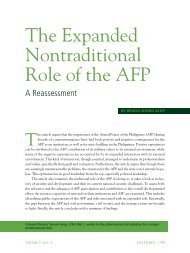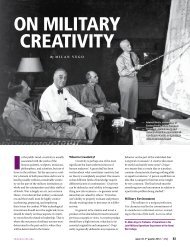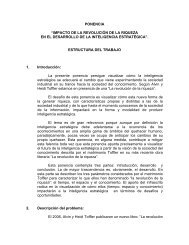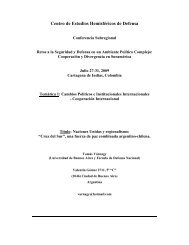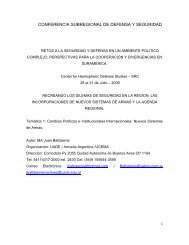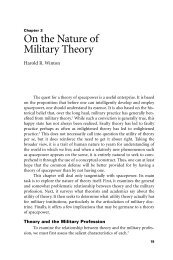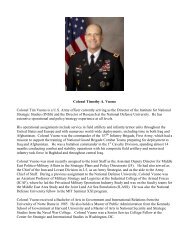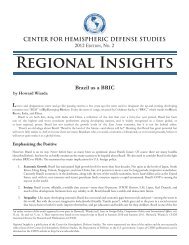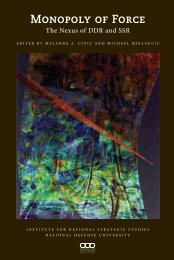In the second half of the 20th century, the US enjoyed pre-eminence ...
In the second half of the 20th century, the US enjoyed pre-eminence ...
In the second half of the 20th century, the US enjoyed pre-eminence ...
Create successful ePaper yourself
Turn your PDF publications into a flip-book with our unique Google optimized e-Paper software.
widely seen as performing important, challenging, and satisfying work. Much <strong>of</strong> <strong>the</strong> DOD’s inhouse<br />
S&T is performed by <strong>the</strong> three service corporate laboratories (Air Force Research<br />
Laboratory [AFRL], Army Research Laboratory [ARL], Naval Research Laboratory [NRL]).<br />
These laboratories should have a special responsibility for maintaining S&T awareness.<br />
Therefore, <strong>the</strong>re is great merit in focusing <strong>the</strong> in-house component <strong>of</strong> <strong>the</strong> S&T workforce in <strong>the</strong><br />
three DOD corporate laboratories so <strong>the</strong> proper culture can be nourished and critical masses <strong>of</strong><br />
card-carrying members in many disciplines can be achieved.<br />
While it is unnecessary to grow <strong>the</strong> in-house S&T workforce in pace with <strong>the</strong> international S&T<br />
workforce, it is never<strong>the</strong>less advisable (within budgetary constraints) to grow this workforce.<br />
C<strong>of</strong>fey has pointed out that <strong>the</strong> defense workforce has not kept pace with <strong>the</strong> national S&T<br />
workforce regarding developing areas <strong>of</strong> S&T. 23 This is worrisome. It will be necessary for <strong>the</strong><br />
in-house workforce to maintain expertise in traditional defense areas. However, entirely new<br />
areas <strong>of</strong> S&T will emerge by 2050 that will be important to DOD. It is essential that <strong>the</strong> DOD inhouse<br />
S&T workforce have expertise in <strong>the</strong>se emerging areas. It is recommended that <strong>the</strong> DOD<br />
in-house S&T workforce be doubled over <strong>the</strong> next 30 years to track <strong>the</strong>se developments while<br />
simultaneously maintaining expertise in <strong>the</strong> traditional areas. This growth should be used to<br />
establish expertise in <strong>the</strong> emerging areas. The resulting 2050 in-house S&T workforce <strong>of</strong> about<br />
30,000 S&Es would <strong>the</strong>n re<strong>pre</strong>sent about 25 percent <strong>of</strong> <strong>the</strong> expected total DOD S&E workforce<br />
in 2050.<br />
External researchers from academia and industry must complement <strong>the</strong> in-house component <strong>of</strong><br />
<strong>the</strong> DOD S&T workforce. These individuals must also be card-carrying members <strong>of</strong> <strong>the</strong> global<br />
S&T community. They must be managed and funded by federal program managers who<br />
<strong>the</strong>mselves are (or were) card-carrying members <strong>of</strong> <strong>the</strong> S&T community and who possess a keen<br />
awareness <strong>of</strong> military needs. An effort should be made to establish a bond between external<br />
researchers and DOD and its S&T aims to extend <strong>the</strong> reach and effectiveness <strong>of</strong> <strong>the</strong> DOD S&T<br />
awareness network. <strong>In</strong>deed, while external researchers are likely to be funded by o<strong>the</strong>r sources as<br />
well, <strong>the</strong>ir bond with DOD will yield better awareness functions for DOD. These bonds become<br />
a means for attracting highly qualified individuals to DOD employment. Fur<strong>the</strong>rmore, external<br />
researchers can enable DOD to better mobilize sectors <strong>of</strong> <strong>the</strong> larger S&T community in times <strong>of</strong><br />
acute and <strong>pre</strong>ssing needs and give DOD a knowledge base suitable to <strong>pre</strong>pare for <strong>the</strong> war after<br />
next.<br />
Although DOD cannot and should not guarantee funding to any component (in-house or not) <strong>of</strong><br />
<strong>the</strong> S&T community, it should embrace <strong>the</strong> concept <strong>of</strong> a DOD S&T community and work to<br />
facilitate interaction and cooperation within this community. It is <strong>the</strong> im<strong>pre</strong>ssion <strong>of</strong> <strong>the</strong> authors<br />
that such a relationship existed between a subset <strong>of</strong> <strong>the</strong> national S&T community and DOD for<br />
several decades after WWII. This post-WWII arrangement, as typified by <strong>the</strong> early Office <strong>of</strong><br />
Naval Research (ONR), was very effective in advancing DOD S&T interests. Unfortunately, <strong>the</strong><br />
early bonds that were established were substantially weakened as DOD became a lesser player in<br />
<strong>the</strong> national S&T program and as <strong>the</strong> concept <strong>of</strong> a DOD S&T community slipped away. It would<br />
be helpful, in addressing <strong>the</strong> globalization <strong>of</strong> S&T, to create a 21st <strong>century</strong> analog <strong>of</strong> <strong>the</strong> post-<br />
WWII DOD S&T community.<br />
23 NDU Defense & Technology Paper Number 49 (2008).<br />
19



